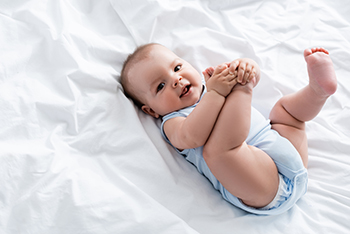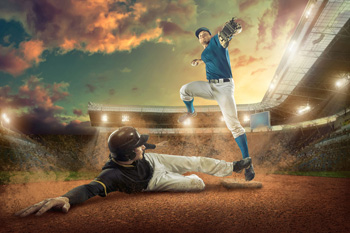May 2024
Genetics and Congenital Foot Problems

Genetics can play a significant role in the development of congenital foot problems, particularly in pediatric patients. Common deformities such as clubfoot, flat feet, and metatarsus adductus often manifest at birth or during early childhood. Clubfoot is characterized by a twisted foot that points downward and inward, whereas flat feet involve a lack of arch in the foot when standing. Metatarsus adductus presents with the front half of the foot turned inward. These conditions are believed to occur due to a combination of genetic and environmental factors, although the precise causes are still not fully understood. Symptoms typically include abnormal foot shape, difficulty in walking, and discomfort. Treatment options vary from custom orthotics to surgical intervention, depending on severity. Prognosis is generally good with early treatment. If you are a parent and notice signs of foot deformities in your children, it is suggested that you schedule an appointment with a podiatrist for diagnosis and appropriate management.
Congenital foot problems require immediate attention to avoid future complications. If you have any concerns, contact John Killough, DPM of Regional Foot Center. Our doctor can provide the care you need to keep you pain-free and on your feet.
Congenital foot problems are deformities affecting the feet, toes, and/or ankles that children are born with. Some of these conditions have a genetic cause while others just happen. Some specific foot ailments that children may be born with include clubfeet, polydactyly/macrodactyly, and cleft foot. There are several other foot anomalies that can occur congenitally. What all of these conditions have in common is that a child may experience difficulty walking or performing everyday activities, as well as trouble finding footwear that fits their foot deformity. Some of these conditions are more serious than others. Consulting with a podiatrist as early as possible will help in properly diagnosing a child’s foot condition while getting the necessary treatment underway.
What are Causes of Congenital Foot Problem?
A congenital foot problem is one that happens to a child at birth. These conditions can be caused by a genetic predisposition, developmental or positional abnormalities during gestation, or with no known cause.
What are Symptoms of Congenital Foot Problems?
Symptoms vary by the congenital condition. Symptoms may consist of the following:
- Clubfoot, where tendons are shortened, bones are shaped differently, and the Achilles tendon is tight, causing the foot to point in and down. It is also possible for the soles of the feet to face each other.
- Polydactyly, which usually consists of a nubbin or small lump of tissue without a bone, a toe that is partially formed but has no joints, or an extra toe.
- Vertical talus, where the talus bone forms in the wrong position causing other bones in the foot to line up improperly, the front of the foot to point up, and the bottom of the foot to stiffen, with no arch, and to curve out.
- Tarsal coalition, when there is an abnormal connection of two or more bones in the foot leading to severe, rigid flatfoot.
- Cleft foot, where there are missing toes, a V-shaped cleft, and other anatomical differences.
- Macrodactyly, when the toes are abnormally large due to overgrowth of the underlying bone or soft tissue.
Treatment and Prevention
While there is nothing one can do to prevent congenital foot problems, raising awareness and receiving neonatal screenings are important. Early detection by taking your child to a podiatrist leads to the best outcome possible.
If you have any questions please feel free to contact our offices located in Charleston and Effingham, IL . We offer the newest diagnostic tools and technology to treat your foot and ankle needs.
Diagnosis and Causes of Hammertoe

Hammertoe, a condition affecting the toes, manifests as an abnormal bend in one or more joints, resembling a hammer's shape. This deformity typically occurs in the second, third, or fourth toe, leading to discomfort and difficulty while wearing shoes. Causes of hammertoe vary, with prominent factors including prolonged wearing of ill-fitting footwear, toe injuries, muscle imbalance, and conditions like arthritis. Diagnosing hammertoe involves a physical examination by a podiatrist, who assesses the toe's flexibility, alignment, and range of motion. Additionally, X-rays may be performed to confirm the diagnosis and evaluate the severity of the deformity. Early detection is essential, as untreated hammertoe can worsen over time, leading to chronic pain and mobility issues. Once diagnosed, treatment options may include orthotic devices, toe exercises, shoe modifications, and in severe cases, surgery to correct the toe's alignment. If you have a hammertoe, it is strongly suggested that you consult a podiatrist who can determine the best course of treatment for you.
Hammertoes can be a painful condition to live with. For more information, contact John Killough, DPM of Regional Foot Center. Our doctor will answer any of your foot- and ankle-related questions.
Hammertoe
Hammertoe is a foot deformity that occurs due to an imbalance in the muscles, tendons, or ligaments that normally hold the toe straight. It can be caused by the type of shoes you wear, your foot structure, trauma, and certain disease processes.
Symptoms
- Painful and/or difficult toe movement
- Swelling
- Joint stiffness
- Calluses/Corns
- Physical deformity
Risk Factors
- Age – The risk of hammertoe increases with age
- Sex – Women are more likely to have hammertoe compared to men
- Toe Length – You are more likely to develop hammertoe if your second toe is longer than your big toe
- Certain Diseases – Arthritis and diabetes may make you more likely to develop hammertoe
Treatment
If you have hammertoe, you should change into a more comfortable shoe that provides enough room for your toes. Exercises such as picking up marbles may strengthen and stretch your toe muscles. Nevertheless, it is important to seek assistance from a podiatrist in order to determine the severity of your hammertoe and see which treatment option will work best for you.
If you have any questions, please feel free to contact our offices located in Charleston and Effingham, IL . We offer the newest diagnostic and treatment technologies for all your foot care needs.
Ankle and Foot Injuries in Baseball

Baseball demands agility, speed, and precise footwork, placing significant strain on the lower extremities, particularly the ankles and feet. Ankle sprains, one of the most prevalent injuries, occur when the ligaments supporting the ankle are overstretched or torn due to sudden twists or impacts. Additionally, conditions like Achilles tendonitis and plantar fasciitis can arise from repetitive stress or inadequate foot support, causing pain and discomfort. To prevent these injuries, players should prioritize proper warm-up exercises to prepare muscles and joints for the demands of the game. Wearing well-fitted, supportive footwear designed for baseball can enhance stability and reduce the risk of injury. Maintaining good conditioning and flexibility through regular strength and flexibility training can improve overall resilience. Emphasizing proper technique, such as avoiding over-striding or landing awkwardly, can also help minimize the risk of ankle and foot injuries. If you have injured your foot or ankle while playing baseball, it is suggested that you visit a podiatrist for an accurate diagnosis and relief tips.
Sports related foot and ankle injuries require proper treatment before players can go back to their regular routines. For more information, contact John Killough, DPM of Regional Foot Center. Our doctor can provide the care you need to keep you pain-free and on your feet.
Sports Related Foot and Ankle Injuries
Foot and ankle injuries are a common occurrence when it comes to athletes of any sport. While many athletes dismiss the initial aches and pains, the truth is that ignoring potential foot and ankle injuries can lead to serious problems. As athletes continue to place pressure and strain the area further, a mild injury can turn into something as serious as a rupture and may lead to a permanent disability. There are many factors that contribute to sports related foot and ankle injuries, which include failure to warm up properly, not providing support or wearing bad footwear. Common injuries and conditions athletes face, including:
- Plantar Fasciitis
- Plantar Fasciosis
- Achilles Tendinitis
- Achilles Tendon Rupture
- Ankle Sprains
Sports related injuries are commonly treated using the RICE method. This includes rest, applying ice to the injured area, compression and elevating the ankle. More serious sprains and injuries may require surgery, which could include arthroscopic and reconstructive surgery. Rehabilitation and therapy may also be required in order to get any recovering athlete to become fully functional again. Any unusual aches and pains an athlete sustains must be evaluated by a licensed, reputable medical professional.
If you have any questions please feel free to contact our offices located in Charleston and Effingham, IL . We offer the newest diagnostic and treatment technologies for all your foot and ankle needs.
Tips for Preventing Running Injuries

Running injuries can affect runners of all levels, from beginners to seasoned athletes. Achilles pain, characterized by discomfort and swelling at the back of the ankle or heel, is a common ailment resulting from the repetitive strain of running. Heel pain, often associated with plantar fasciitis, can feel like a sharp sensation when pressure is applied to the heel or bottom of the foot. To prevent such running injuries, it's important to take proactive measures. First and foremost, wearing the right shoes is essential, but remember, expensive doesn't always mean better. Additionally, warming up properly before a run with brisk walking or gentle jogging for five to 10 minutes can prepare muscles and reduce the risk of injury. Similarly, cooling down post-run with easy-paced jogging or walking helps muscle recovery. Last, avoid the temptation to increase running intensity or distance too rapidly. Build up your running regimen gradually by increasing distance and duration a week at a time. By utilizing these methods, runners can minimize the likelihood of common running injuries. If foot or ankle pain from running persists or worsens, it is suggested that you seek help from a podiatrist.
Exercising your feet regularly with the proper foot wear is a great way to prevent injuries. If you have any concerns about your feet, contact John Killough, DPM of Regional Foot Center. Our doctor will treat your foot and ankle needs.
How to Prevent Running Injuries
Many common running injuries are caused by overuse and overtraining. When the back of the kneecap starts wearing out and starts causing pain in your knee, this is commonly referred to as runner’s knee. Runner’s knee is a decrease in strength in your quadriceps and can occur if you’re not wearing properly fitted or supporting shoes. To prevent runner’s knee, focusing on hip strengthening is a good idea, as well as strengthening your quads to keep the kneecaps aligned.
What Are Some Causes of Running Injuries?
- One cause of a common running injury is called iliotibial band syndrome.
- Plantar fasciitis is also another common injury.
- Stress fractures can occur from overtraining, lack of calcium, or even your running style.
Best Ways to Prevent Running Injuries
- Wear footwear that fits properly and suits your running needs.
- Running shoes are the only protective gear that runners have to safeguard them from injury.
- Make a training schedule. Adding strengthening exercises as well as regular stretching can help keep you strong and limber and can lessen the possibility of injuries.
- Stretching keeps muscles limber; this will help you gain better flexibility.
If you have any questions please feel free to contact our offices located in Charleston and Effingham, IL . We offer the newest diagnostic and treatment technologies for all your foot and ankle needs.





